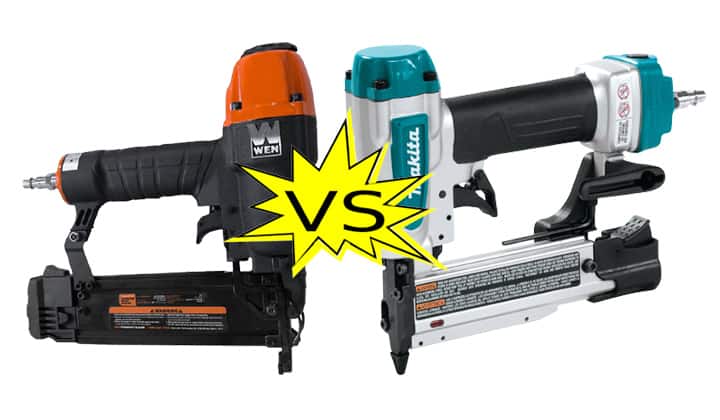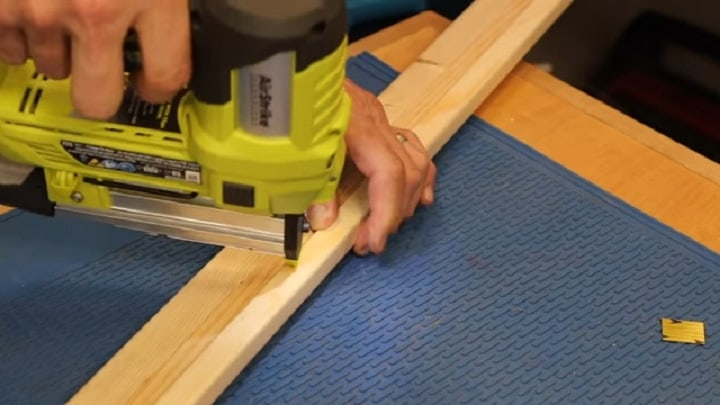Ou te fiafia e fatu fua fua mea tumu i fautuaga mo laʻu au faitau, oe. Ou te le taliaina totogi lagolago, o loʻu manatu o laʻu lava ia, ae afai e te iloa aʻu fautuaga aoga ma e iʻu i le faʻatauina o se mea e te fiafia i ai e ala i se tasi o aʻu fesoʻotaʻiga, E mafai ona ou mauaina se komisi e aunoa ma se tau faʻaopoopo ia te oe. Aoao atili
Nails and pins are the barebone necessities of carpentering and any wood-related projects. They eliminate or reduce the need to use glue to stick pieces of wood together.
However, there are different kinds of pins and nailers. The ones we’ll be talking about today are brad nailers and pine fao. Both of these serve different purposes, yet they are very similar.

I lenei tulaga o le a tatou aofia ai:
Brad Nailer
A brad nailer is the most popular wood nailer used by both professionals and casuals. Its main purpose is to pin nails deep within wood pieces to stick them together and reduce the need for glue. Generally, a brad nailer is ideal for a broad range of tasks. They use 18-gauge nails that are around 3/8 to 2 inches tall. So the nails are thin yet very long. This is useful to permanently attach multiple pieces of wood, as long as their thickness is within the length of the pin. Also, thanks to nails being thin, they barely leave any marks on the wood and are very unnoticeable. Brad nailers work very fast, so they are preferred by most professionals as their go-to method for stacking wood. The nails also have sufficient holding power so they can stick thick and heavy pieces of wood.When to Use Brad Nailers?
Typically, brad nailers are used for most projects involving wood and casual household fixes. This includes attaching two pieces of wood, such as fixing a wooden chair or cabinetry. And since brad nailers don’t leave much of a spot, you don’t need to cover them up. They are also recommended for most professional work as they come in very handy – thanks to their speed. When you need to insert a ton of pins one by one, a brad nailer will make the job a whole lot easier and faster.Pin Nailer
This type of nailer uses very thin and small pins (usually around 23-gauges). This is not suitable for every kind of work as the pins are weak. But usually, they are great for small projects and attaching small wood pieces.
When to Use a Pin Nailer?
Pin nailers should be used for delicate and small applications. This includes small projects, attaching small wooden picture frames, and other miniature fixes. The pin nailer is also quite small, so you can tuck it into small places. It can also be used for temporary wooden works. Providing support for the wood while the glue dries up is the most common use in this regard. It will also help strengthen the bonding of the wood pieces.Differences Between Brad Nailers and Pin Nailers
So now that we’ve laid down the basic ground knowledge for both the machines, it’s time to know the differences between them to help you get a better understanding.| Brad Nailer | Pin Nailer |
| Has a wide variety of use case scenarios | Field of usage is limited and small |
| Uses 18-gauge nails that are very long | Supports 23-gauge nails that are short |
| Can permanently attach and stick pieces of wood | Only used to temporarily stick wood pieces |
| Not suitable for thin and small projects and fixes | Very suitable for little projects and attaching thin wood |
| Used for the mainframe of work | Mostly used for very thin finishing works and support |
| Leaves a visible nail head on the wood surface | Gets deep into the wood, leaving no visible trace |
O le fea e tatau ona e mauaina?
After learning about all the facts and differences between the brad nailer and the pin nailer, the decision comes down to you and your needs. If you’re new and you’re looking at casual household uses, then buy a brad nailer. It offers more versatility and will get most of the work done. However, if you’re a professional or you have a certain niche that requires small nails, such as tiny projects and thin woodworks, then you might want to consider the pin nailer. Both of these are useful in different scenarios, but the only major thing that differs them is the holding power of the brad nailer, as it can permanently attach woods.iʻuga
So, after all the conversation, which one should you get? If you are very confused about both of these, then going for a brad nailer is usually a safe pick. However, it is always better to get informed and think about your personal use cases. Hopefully, this article has helped you in your research, and now you can confidently make a purchase decision. Good luck!O aʻu o Joost Nusselder, o le na faavaeina le Tools Doctor, faʻatau oloa, ma tama. Ou te fiafia e faʻataʻitaʻi meafaigaluega fou, ma faʻatasi ai ma laʻu 'au sa ou fatuina ni tusiga blog loloto talu mai le 2016 e fesoasoani ai i le au faitau faamaoni i meafaigaluega & faʻamatalaga tufuga.
